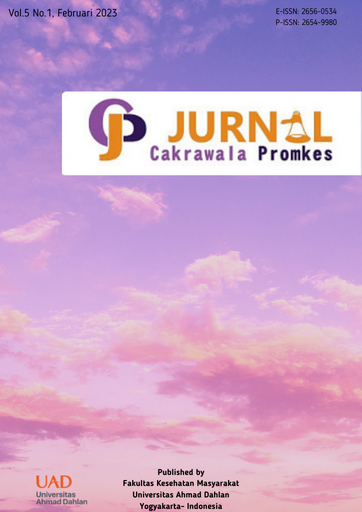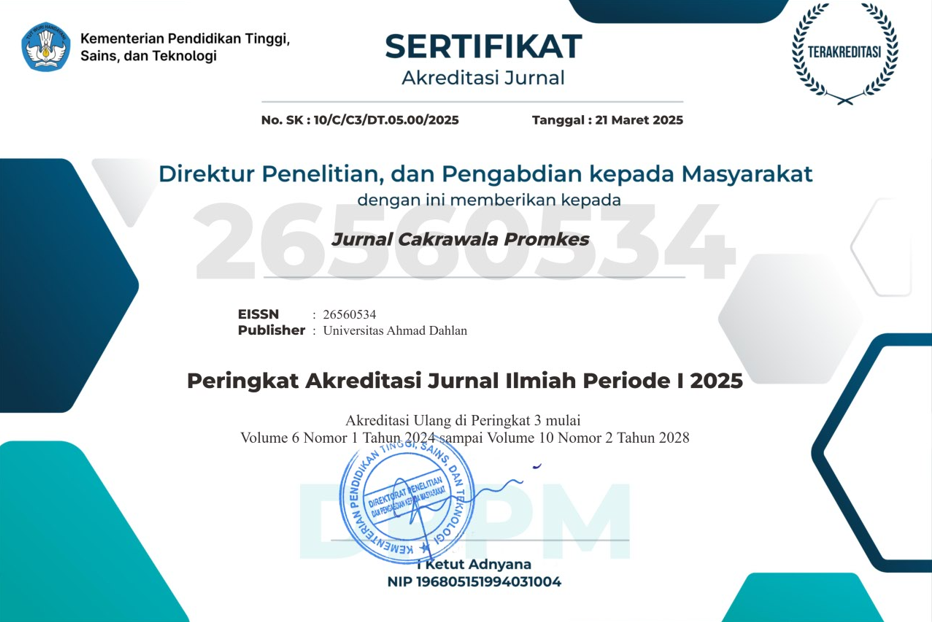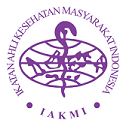The characteristic and clinical profiles among COVID-19 patients at the National Emergency Hospital Wisma Atlet Jakarta in 2021
DOI:
https://doi.org/10.12928/promkes.v5i1.6254Keywords:
COVID-19, SARS-COV-2;, Pandemic, Emergency, ZoningAbstract
The World Health Organization designated Covid-19, caused by SARS-COV-2, a worldwide pandemic on March 11, 2020, and it has been entering Indonesia since early March 2020. This study attempts to elucidate and map patients' profiles and essential emergency preparedness measures during a national crisis. This research used an exploratory descriptive technique with structured interviews to collect data on retrospective data from hospital patients. The ethical clearance was issued prior to data collection, and informed permission was in accordance with the ethical clearance. The total number of patients treated in the COVID-19 National Emergency Hospital Wisma Atlet Kemayoran (RSDCWAK) was 69,965, and structured interviews were conducted with 46,408 patients. Demographic data of the patients consisted of 49.06% female and 50.04% male patients. Patients were aged 20-49 years (68.08%), and 76.05% of patients had mild symptoms. Hypertension was the highest comorbid at 6.11%, with common symptoms experienced. Most patients received vaccines (34.14%) with the highest type of vaccine (Sinovac 22.26%). To minimize the spread of COVID-19, RSDC WAK has implemented a zoning policy in its building, including red for COVID-19 patients with a risk of severe infection, yellow for patients with risk of mild infection, and green for areas free of COVID-19 and forbidden for COVID-19 patients. The COVID-19 pandemic has become a global health problem. The COVID-19 pandemic has become a global health problem. No one knows when the COVID-19 pandemic will end because the virus constantly changes and creates new variants. Proper regulations and human resources are required to have the readiness to control COVID-19. Zoning is the most appropriate way to prevent the spread of COVID-19 at RSDCWAK.
References
Helmi, M., Sari, D., Meliala, A., & Trisnantoro, L. (2021). What Is Preparedness and Capacity of Intensive Care Service in Indonesia to Response to COVID-19? A Mixed-method Study. Open Access Macedonian Journal of Medical Sciences, 9(B), 1686-1694.
Ariawan I, Jusril H. COVID-19 in Indonesia: Where Are We? Acta Med Indones. Jul 2020;52(3):193-195.
Carenzo L, Costantini E, Greco M, et al. Hospital surge capacity in a tertiary emergency referral centre during the COVID-19 outbreak in Italy. Anaesthesia. Jul 2020;75(7):928-934. doi:10.1111/anae.15072
Cammarota G, Ragazzoni L, Capuzzi F, et al. Critical Care Surge Capacity to Respond to the COVID-19 Pandemic in Italy: A Rapid and Affordable Solution in the Novara Hospital. Prehosp Disaster Med. Aug 2020;35(4):431-433. doi:10.1017/S1049023X20000692
Barasa EW, Ouma PO, Okiro EA. Assessing the hospital surge capacity of the Kenyan health system in the face of the COVID-19 pandemic. PLoS One. 2020;15(7):e0236308. doi:10.1371/journal.pone.0236308
Hettle D, Sutherland K, Miles E, et al. Cross-skilling training to support medical redeployment in the COVID-19 pandemic. Future Healthc J. Oct 2020;7(3):e41-e44. doi:10.7861/fhj.2020-0049
Dhanani J, Pang G, Pincus J, et al. Increasing ventilator surge capacity in COVID 19 pandemic: design, manufacture and in vitro-in vivo testing in anaesthetized healthy pigs of a rapid prototyped mechanical ventilator. BMC Res Notes. Sep 7 2020;13(1):421. doi:10.1186/s13104-020-05259-z
Al-Busaidi IS, Martin M. Provision of primary care in managed isolation and quarantine facilities during the COVID-19 pandemic: lessons learned from Christchurch, New Zealand. N Z Med J. Jul 31 2020;133(1519):130-132.
Abdullah I. COVID-19: Threat and fear in Indonesia. Psychol Trauma. Jul 2020;12(5):488-490. doi:10.1037/tra0000878
Omess S, Kaplow R, Green A, et al. Implementation of a Warm Zone Model During the COVID-19 Pandemic. Am J Nurs. Jan 1 2021;121(1):48-54.doi:10.1097/01.NAJ.0000731664.58705.c3
Occhipinti V, Pastorelli L. Challenges in the Care of IBD Patients During the CoViD-19 Pandemic: Report From a “Red Zone” Area in Northern Italy. Inflamm Bowel Dis. May 12 2020;26(6):793-796. doi:10.1093/ibd/izaa084
Chong CF. Dividing the Emergency Department into Red, Yellow, and Green Zones to Control COVID-19 Infection; a Letter to Editor.Arch Acad Emerg Med. 2020;8(1):e60.
Wen, et al. “Clinical Characteristics and Outcomes of COVID-19 in West Virginia.” Viruses vol. 13,5 835. 5 May. 2021, doi:10.3390/v13050835
Djaharuddin, Irawaty et al. “Comorbidities and mortality in COVID-19 patients.” Gaceta sanitaria vol. 35 Suppl 2 (2021): S530-S532. doi:10.1016/j.gaceta.2021.10.085
Zhou, et al. “A pneumonia outbreak associated with a new coronavirus of probable bat origin.” Nature vol. 579,7798 (2020): 270-273. doi:10.1038/s41586-020-2012-7
Channappanavar, Rudragouda et al. “Sex-Based Differences in Susceptibility to Severe Acute Respiratory Syndrome Coronavirus Infection.” Journal of immunology (Baltimore, Md. : 1950) vol. 198,10 (2017): 4046-4053. doi:10.4049/jimmunol.1601896
Elviani, R., Anwar, C., & Sitorus, R.J. Gambaran usia pada kejadian COVID-19. JMJ, Volume 9, Nomor 2 Mei 2021, Hal: 204-209 https://online-journal.unja.ac.id/kedokteran/citationsty lelanguage/download /bibtex?submissionId=11263&publicationId=24891
Israfil et al. Clinical Characteristics and Diagnostic Challenges of COVID−19: An Update From the Global Perspective. Front. Public Health 8:567395 (2021). doi: 10.3389/fpubh.2020.567395
Akpek, Mahmut. “Does COVID-19 Cause Hypertension?” Angiology, Dec. 2021, doi:10.1177/00033197211053903.
Lippi, Giuseppe et al. “Hypertension in patients with coronavirus disease 2019 (COVID-19): a pooled analysis.” Polish archives of internal medicine vol. 130,4 (2020): 304-309. doi:10.20452/pamw.15272
Guo, Weina et al. “Diabetes is a risk factor for the progression and prognosis of COVID-19.” Diabetes/metabolism research and reviews, e3319. 31 Mar. 2020, doi:10.1002/dmrr.3319
Elemam, Noha M et al. “Diabetes mellitus as a comorbidity in COVID-19 infection in the United Arab Emirates.” Saudi medical journal vol. 42,2 (2021): 170-180. doi:10.15537/smj.2021.2.25700
Syam, A.F., Zulfa, F.R., Karuniawati, A. Manifestasi Klinis dan Diagnosis Covid-19. eJKI, Vol 8,3 (2021).
Tsai, et al. Clinical manifestation and disease progression in COVID-19 infection, Journal of the Chinese Medical Association: January 2021 - Volume 84 - Issue 1 - p 3-8 doi: 10.1097/JCMA.0000000000000463
Mesquita, et al. “Clinical manifestations of COVID-19 in the general population: systematic review.” Wiener klinische Wochenschrift vol. 133,7-8 (2021): 377-382. doi:10.1007/s00508-020-01760-4
Hitchings, et al. Effectiveness of CoronaVac in the setting of high SARS-CoV-2 P.1 variant transmission in Brazil: A test-negative case-control study. DOI: 10.1101/2021.04.07.21255081
Bernal, et al. “Effectiveness of the Pfizer-BioNTech and Oxford-AstraZeneca vaccines on covid-19 related symptoms, hospital admissions, and mortality in older adults in England: test negative case-control study.” BMJ (Clinical research ed.) vol. 373 n1088. 13 May. 2021, doi:10.1136/bmj.n1088
Meo, S.A., Bukhari, I.A., Akram, J., Meo, A.S., & Klonoff, D.C. “COVID-19 vaccines: comparison of biological, pharmacological characteristics and adverse effects of Pfizer/BioNTech and Moderna Vaccines.” European review for medical and pharmacological sciences vol. 25,3 (2021): 1663-1669. doi:10.26355/eurrev_202102_24877
de Souza, Tiago H et al. “Clinical manifestations of children with COVID-19: A systematic review.” Pediatric pulmonology vol. 55,8 (2020): 1892-1899. doi:10.1002/ppul.24885
Neto ARdS, Carvalho ARBd, Oliveira EMNd, et al. Symptomatic manifestations of the disease caused by coronavirus (COVID-19) in adults: systematic review. SciELO Preprints; 2020. DOI: 10.1590/scielopreprints.1436.
Arini, M., Sugiyo, D., & Permana, I. (2021). Challenges, opportunities, and potential roles of the private primary care in tuberculosis and diabetes mellitus (TB-DM) collaborative care and control: a qualitative study. https://assets.researchsquare.com/files/rs-153508/v1/b05b629e-5b36-47d1-a8aa-3e6d1c2bbacf.pdf?c=1631873355
Downloads
Published
Issue
Section
License
Copyright (c) 2022 Misriania, M Helmi , Arif Sujagat, Lutfi Rinaldi Syahbana, Wahyu Setiyowati, Tjahja Nurobi, Budiman, Tri Setyanti, Imelda Sussanti, Dianita Sugiyo, Noven Tri Wandasari, Faudyan Eka Satria

This work is licensed under a Creative Commons Attribution-ShareAlike 4.0 International License.
Authors who publish with JCP: Jurnal Cakrawala Promkes agree to the following terms:
- Authors retain copyright and grant the journal the right of first publication with the work simultaneously licensed under a Creative Commons Attribution License (CC BY-SA 4.0) that allows others to share the work with an acknowledgement of the work's authorship and initial publication in this journal.
- Authors are able to enter into separate, additional contractual arrangements for the non-exclusive distribution of the journal's published version of the work (e.g., post it to an institutional repository or publish it in a book), with an acknowledgement of its initial publication in this journal.
- Authors are permitted and encouraged to post their work online (e.g., in institutional repositories or on their website) prior to and during the submission process, as it can lead to productive exchanges, as well as earlier and greater citation of published work.

This work is licensed under a Creative Commons Attribution-ShareAlike 4.0 International License












